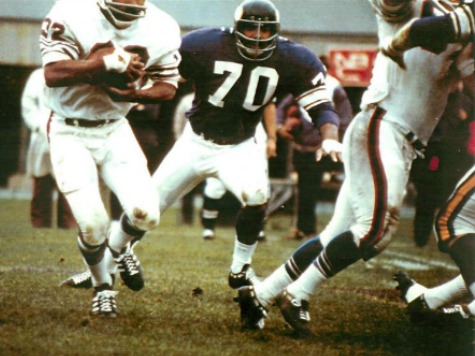Judge Anita Brody on Tuesday temporarily blocked the $765 million settlement between the NFL and more than 4,000 players suing it for “sustained repetitive [mild traumatic brain injury] while in the NFL,” who “now suffer from latent neurodegenerative disorders and diseases, all of which, in whole or in part, were caused by the NFL’s acts and/or omissions.”
The judge fears that so many players may quickly drain the money pool. “Even if only 10 percent of Retired NFL Football Players eventually receive a Qualifying Diagnosis,” the federal judge explains, “it is difficult to see how the Monetary Award Fund would have the funds available over its lifespan to pay all claimants at these significant award levels.”
For instance, the agreement to award $4 million to families should an autopsy find chronic traumatic encephalopathy (CTE)–when there’s no agreed upon definition for the disease or understanding of its incidence in society–in a deceased player seems a recipe for disaster. If neuropathologists issue postmortem CTE diagnoses to 180 of the 18,000 qualifying former NFL players, the entire settlement would evaporate. What, then, would become of the players who require care for Parkinson’s, Alzheimer’s, and Lou Gehrig’s disease while still alive?
It’s difficult to gainsay Judge’s Brody’s addition. Her solution is another matter. Why does the judge believe the answer to the math problem lies in the NFL paying out even more money? Why not pare down the number of plaintiffs?
Start with Jimmy Keyes. He kicked seven field goals for the Miami Dolphins during the 1968 season. Basic anatomy instructs that his specialized role could possibly harm the bodily extension furthest from the brain. But you would really have to have your brain in your foot to buy into the idea that kicking a ball in seventeen NFL games caused brain damage.
Nolan Franz caught one Randy Wright pass during his lone NFL appearance for the woeful 1986 Green Bay Packers in a 55-24 shellacking against the New York Giants. Does Judge Brody really agree that a single game in the NFL, rather than several seasons in the USFL, a collegiate career at Tulane, four years at Metairie, Louisiana’s East Jefferson High, and any additional play in sandlot leagues, left Franz permanently damaged?
Robert DiRico competed in three disastrous replacement games for the Giants during the 1987 players’ strike, which helped keep the defending Super Bowl champs out of the playoffs. Back then, striking players dehumanized the replacements as “scabs,” spit on them, and busted out the windows of the buses that ushered them into practice facilities. Now they join them in suing the NFL. For the court to regard the case of DiRico, who played in three games against marginal talent during a labor stoppage, as legitimate as, say, the case of Fred Smerlas, who played more downs at nose guard than anyone in the history of the NFL, suggests that justice truly is blind.
At least Franz, Keyes, and DiRico played in the league they’re suing. The best-kept secret of the NFL concussion lawsuit is that a huge chunk of the plaintiffs weren’t players–at least in the NFL. About one out of every nine litigants suing the NFL never actually entered an official NFL game. By far, the largest “games played” category in the Washington Times database on the lawsuit is “0.”
The database lists such non-playing plaintiffs as 1989 Kansas City Chiefs cut Richard van Druten, a South African late bloomer who played a game neither in high school nor in the NFL; Michael Attardi, a kicker released by the Los Angeles Raiders before the 1992 season; and Bill Jaco, an Ohio State tight end who spent the 1980 season on injured reserve before receiving his walking papers from the Houston Oilers. That taxi-squad players and preseason cuts could comprise such a large portion of the litigants suggests that the NFL doesn’t have a monopoly on greed.
Given that the settlement incentivizes clinical diagnoses of numerous conditions that can’t be confirmed until death, players who brought dubious cases against the league might now doctor shop for dubious diagnoses. For instance, Breitbart Sports exposed headline-grabbing diagnoses of CTE in living players, including Tony Dorsett and Leonard Marshall, as media hoaxes in November. Not only had the doctors praising the diagnostic tool in the press recently founded the company standing to profit from it, they all had gone on record in academic journals in 2013–before they launched the company but after the majority of their player-subjects had been examined–that CTE could only be diagnosed posthumously.
And opening up the pot of money to all 18,000 living men who made their way into an NFL locker room at some point invites greater mischief. As Hal Wortzel, Lisa Brenner, and David Arciniegas of the University of Colorado School of Medicine wrote this fall past in Behavioral Sciences and the Law, “the potential for malingering is real when litigation is a factor, and various authors have reported significant base rates (up to 40%) of malingering in brain injury litigation.” What safeguards does the agreement have in place for inevitable malingering? Given the fixed nature of the settlement, fakers will be takers not from the NFL but from peers who might need funding for legitimate medical concerns.
Judge Brody rightly grasps that the complex mathematical formulas guiding settlement payoffs to individual players won’t add up to $765 million. The money eventually demanded by the litigants will vastly exceed it. Wresting more cash from the three-lettered, $10 billion behemoth while empowering never-was-beens to siphon funds from hurting has-beens isn’t justice. Shedding plaintiffs who joined the suit to hit the litigation lottery is.
This settlement’s math doesn’t add up. The just solution involves subtraction, not addition.

COMMENTS
Please let us know if you're having issues with commenting.